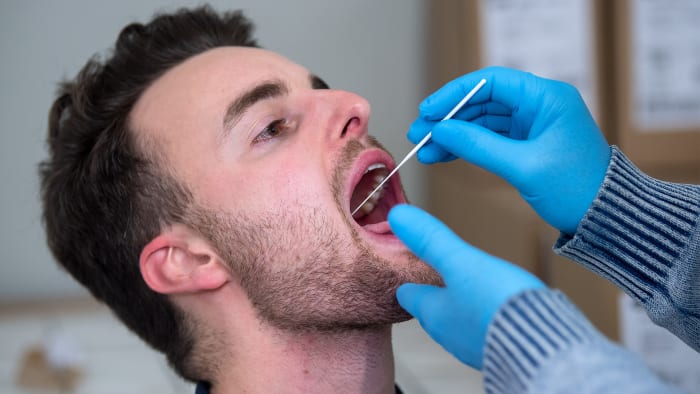Few drug developers are more ambitious than Sarepta Therapeutics (SRPT) - Get Sarepta Therapeutics Inc. Report. The company boasts 34 pipeline programs spread across gene therapy, gene editing, and tools based on RNA. Although the company is primarily focused on muscle disorders such as Duchenne muscular dystrophy (DMD), it has recently branched out into diseases impacted by genes in the liver and brain. If its three approved drug products continue to ramp revenue, then the business could reach profitability near the middle of the decade.
Despite the breadth of the pipeline and portfolio, Wall Street analysts have trained investors to focus their attention on a single program: a gene therapy for DMD named SRP-9001. On the one hand, the program is financially important. Sarepta Therapeutics licensed international development rights to Roche (RHHBY) for $1.15 billion in upfront cash. It could also earn up to $1.7 billion in milestone payments, plus royalties on future sales.
On the other hand, biotech stocks that become too attached to a single pipeline program expose investors to significant volatility. That's become a headache in recent years, as preliminary clinical data for SRP-9001 have underwhelmed at worst and been mixed at best.
Investors have no control over stock volatility. However, those who can keep their emotions in check might be able to see another major opportunity hiding in plain sight.
A Next-Generation Approach to Proven Tech
Sarepta Therapeutics is developing a next-generation version of the tool that led to its three drug approvals from the U.S. Food and Drug Administration (FDA). Preliminary clinical data suggest the first program could be 18x more effective than an existing drug on a key metric.
- Prior-generation tool: The company's three FDA-approved products are based on RNA tools called morpholinos. If we take the nerdy chemical name of the molecules, then they earn the abbreviation PMOs.
- Next-generation tool: A part of the company's RNA pipeline is based on next-generation morpholinos. These molecules earn the abbreviation PPMOs.
Both PMOs and PPMOs work by blocking cells from reading instructions to make proteins. If the disrupted reading instructions code a mutation, then the cell might be able to create functional protein. That could have therapeutic potential in diseases caused by simple, short mutations resulting in faulty proteins that don't do their job.
For example, DMD is caused by mutations in the dystrophin gene. Dystrophin is a protein that helps muscles function properly. Individuals with DMD have one of several mutations that result in dysfunctional dystrophin protein, which results in progressively worse muscle, heart, and lung function.
Sarepta Therapeutics designed PMO drugs to skip over instructions for making mutated dystrophin in three separate mutations. Although each led to increases in production of working dystrophin proteins, the results were controversial. Patients receiving Exondys 51 achieved dystrophin levels that were 1% of normal.
Despite debate in the scientific community, the company earned multiple approvals. The three drugs earned combined product revenue of $612 million in 2021, which is expected to exceed $1 billion in 2023.
That's what makes the emerging PPMO platform so exciting. The next-generation tools make chemical modifications to a traditional morpholino that increase potency and reduce side effects. The lead drug candidate, SRP-5051, has delivered impressive results in clinical trials to date.
- Patients receiving the highest dose of SRP-5051 block an average of 10.5% of the mutated instructions after 12 weeks of treatment. That represented an 18x increase compared to 24 weeks of treatment with Exondys 51.
- Patients receiving the highest dose of SRP-5051 achieved an average dystrophin production that was 6.5% of normal after 12 weeks of treatment. That represented an 8x increase compared to 24 weeks of treatment with Exondys 51.
- Patients receive SRP-5051 through an intravenous (IV) infusion once every four weeks, compared to a weekly IV infusion for Exondys 51.
Sarepta Therapeutics thinks SRP-5051 can achieve even better outcomes over longer periods of time. Simulations from the company suggest the PPMO compound could achieve dystrophin levels that are 14% of normal after 96 weeks of treatment. That compares to just over 1% for Exondys 51.It's important to acknowledge two things. First, the PPMO portfolio's success would come at the expense of currently-approved drug products. There would likely be some cannibalization of revenue, but the increased effectiveness and reduced dosing schedule could also lead to greater patient access and faster growth. In other words, PPMOs could have much higher peak annual revenue than their predecessors.
Second, there's one worrisome side effect from SRP-5051. Patients receiving the highest dose tested in ongoing clinical trials have developed hypomagnesemia, or low levels of magnesium in the blood. This should be relatively easy to treat with monitoring and magnesium supplementation, but the FDA did recently place a clinical trial on hold to gather more data and potentially recommend a change in the study design.
The worst-case scenario is that hypomagnesemia is caused by kidney damage. The kidneys process and clear PPMOs from the body, but their unique chemical modifications -- the very engineering decisions that make them a next-generation morpholino to begin with -- could also cause them to clump together inside these essential organs. So far, other key measurements of kidney function appear normal in patients, but it's something for investors to keep an eye on nonetheless.
Keep an Eye on PPMOs at Sarepta Therapeutics
Investors have been trained to focus on the gene therapy program known as SRP-9001, but the PPMO platform represents a significant economic opportunity. The emerging tools apply important upgrades to a proven, FDA-approved therapeutic modality. The result could be a portfolio of safer, more effective, and more convenient treatment options for individuals with DMD. Importantly, commercializing PPMOs could maintain Sarepta Therapeutics' lead in DMD treatment, especially if gene therapies and gene editors from the company's own pipeline or the competitive landscape prove less effective in upcoming clinical trials.
https://www.thestreet.com/investing/sarepta-therapeutics-ppmo-platform



